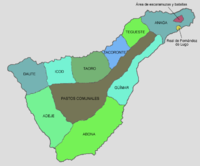

Güímar was one of nine menceyatos guanches (native kingdom) that was divided island of Tenerife (Canary Islands, Spain) at the time of the arrival of the Castilian conquerors. Occupied an area significantly greater than the actual municipality of Güímar, including part of Santa Cruz de Tenerife and San Cristóbal de La Laguna, El Rosario, Candelaria, Arafo and Fasnia, himself and perhaps a small part of the town of Arico.

Guanches were the aboriginal inhabitants of the Canary Islands. In 2017, the first genome-wide data from the Guanches confirmed a North African origin and that they were genetically most similar to modern North African Berber peoples of the nearby North African mainland. It is believed that they migrated to the archipelago around 1000 BCE or perhaps earlier.

Tenerife is the largest and most populated island of the seven Canary Islands. It is also the most populated island of Spain, with a land area of 2,034.38 square kilometres (785 sq mi) and 904,713 inhabitants, 43 percent of the total population of the Canary Islands. Tenerife is the largest and most populous island of Macaronesia.

The Canary Islands is a Spanish archipelago and the southernmost autonomous community of Spain located in the Atlantic Ocean, 100 kilometres west of Morocco at the closest point. The Canary Islands, which are also known informally as the Canaries, are among the outermost regions (OMR) of the European Union proper. It is also one of the eight regions with special consideration of historical nationality recognized as such by the Spanish Government. The Canary Islands belong to the African Plate like the Spanish cities of Ceuta and Melilla, the two on the African mainland.
In Güímar saw the appearance of the image of the Virgin of Candelaria (patroness of the Canary Islands). Hence, this city played an important role in the evangelization of the whole archipelago. Around 1450 a hermitage formed by three friars led by Alfonso de Bolaños, considered the «Apostle of Tenerife», was founded in the area of the modern city of Candelaria. These religious lived among the Guanches, speaking their language and baptizing many of them. This mission would last until near the beginning of the conquest.

The Virgin of Candelaria or Our Lady of Candelaria, popularly called La Morenita, celebrates the Virgin Mary on the island of Tenerife, one of the Canary Islands (Spain). The center of worship is located in the city of Candelaria in Tenerife. She is depicted as a Black Madonna. The "Royal Basilica Marian Shrine of Our Lady of Candelaria" is considered the main church dedicated to the Virgin Mary in the Canary Islands and she is the patron saint of the Canary Islands. Her feast is celebrated on February 2 and August 15, the patronal feast of the Canary Islands.
Alfonso de Bolaños was a Franciscan friar and missionary of the 15th century. He is nicknamed the "Apostle of Tenerife" because he initiated an evangelizing process on this island approximately 30 years before the conquest of it.
It is believed that the first Mencey of Güímar could have been Acaymo, later succeeded by his son Añaterve. The latter who would reign in time of the conquest of Tenerife by Alonso Fernandez de Lugo. [1]

Añaterve was the Guanche mencey (king) of Menceyato de Güímar at the time of the conquest of Tenerife in the 15th century.






